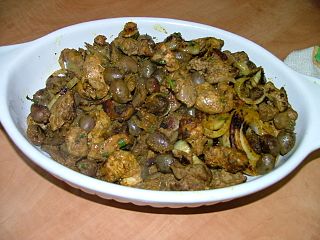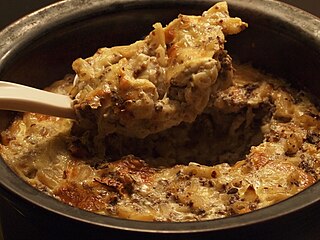
A sausage is a type of meat product usually made from ground meat—often pork, beef, or poultry—along with salt, spices and other flavourings. Other ingredients, such as grains or breadcrumbs, may be included as fillers or extenders.

Louisiana Creole cuisine is a style of cooking originating in Louisiana, United States, which blends West African, French, Spanish, and Native American influences, as well as influences from the general cuisine of the Southern United States.

Teriyaki is a cooking technique in which foods are broiled or grilled with a glaze of soy sauce, mirin, and sugar. Although commonly associated with Japanese cuisine, this cooking technique is also commonly used in other Asian cuisines such as Chinese, Indonesian and Thai.

Nokia is a town in the Pirkanmaa region of Finland. It lies on the banks of the Nokianvirta, a river of the Kokemäki River watershed, and is situated in the Tampere metropolitan area, about 15 kilometres (9 mi) west of Tampere proper. The population of Nokia is approximately 36,000, while the Tampere metropolitan area has a population of approximately 421,000. It is the 33rd most populous municipality in Finland, and the second largest in the Pirkanmaa region after Tampere.

The cuisine of California reflects the diverse culture of California and is influenced largely by European American, Hispanic American, East Asian and Oceanian influences, and Western European influences, as well as the food trends and traditions of larger American cuisine.

Kebab, kabob, kebap, kebob, or kabab is a variety of roasted meat dishes that originated in the Middle East.

Indonesian cuisine is a collection of various regional culinary traditions that formed in the archipelagic nation of Indonesia. There are a wide variety of recipes and cuisines in part because Indonesia is composed of approximately 6,000 populated islands of the total 17,508 in the world's largest archipelago, with more than 1,300 ethnic groups.

The cuisine of the Southwestern United States is food styled after the rustic cooking of the Southwestern United States. It comprises a fusion of recipes for things that might have been eaten by Spanish colonial settlers, cowboys, Mountain men, Native Americans, and Mexicans throughout the post-Columbian era; there is, however, a great diversity in this kind of cuisine throughout the Southwestern states.

Different areas of the world have local variations on the hot dog, in the type of meat used, the condiments added, and its means of preparation.
Restaurants fall into several industry classifications, based upon menu style, preparation methods and pricing, as well as the means by which the food is served to the customer. This article mainly describes the situation in the US, while categorisation differs widely around the world.

Porilainen is a sandwich and street food dish in Finnish cuisine made from white bread and a thick slice of sausage, normally jagdwurst. Additional ingredients may include diced sweet onion, chopped pickled cucumber, ketchup, mustard, and in some cases mayonnaise or fried egg.

Jerusalem mixed grill is a grilled meat dish considered a specialty of Jerusalem. It consists of chicken hearts, spleens and liver mixed with bits of lamb cooked on a flat grill, seasoned with onion, garlic, black pepper, cumin, turmeric, olive oil and coriander.

Macaroni casserole is a dish of baked pasta. It is especially known as a staple in northern European home cooking. It is a dish of cooked macaroni and a mixture of egg and milk with additional ingredients like meats, vegetables or fish. It is commonly made with cheese or breadcrumbs sprinkled on top.

Kuku or kookoo is an Iranian and Azerbaijani dish made of whipped eggs with various ingredients folded in. It is similar to the Italian frittata, the French quiche, or an open-faced omelette, but it typically has less egg than a frittata, and is cooked for a shorter time, over a low heat, before being turned over or grilled briefly to set the top layer. It is served either hot or cold as a starter, side dish, or a main course, and is accompanied with bread and either yogurt or salad.

Batak cuisine is the cuisine and cooking traditions of Batak ethnic groups, predominantly found in Northern Sumatra region, Indonesia. Batak cuisine is part of Indonesian cuisine, and compared to other Sumatran cuisine traditions, it is more indigenously preserved. One characteristic of Batak cuisine is its preference to andaliman as the main spice. That is why andaliman in Indonesia sometimes dubbed as "Batak pepper".

North Korean cuisine is the traditional culinary practices and dishes of North Korea. Its foundations are laid by the agricultural and nomadic traditions in southern Manchuria and the Korean Peninsula. Some dishes are shared by the two Koreas; however, availability and quality of Northern cuisine is much more significantly affected by sociopolitical class divides.

The cuisine of Papua New Guinea are the traditional varied foods found in the eastern part of the New Guinea island. Approximately 80% of the population is reliant on subsistence agriculture, so a large percentage of food energy and protein consumed in Papua New Guinea is produced locally, while the balance is imported. The staple foods in Papua New Guinea includes root crops, bananas, and sago. Papua New Guinea's diet is largely vegetarian, especially in the Gulf and Highlands regions.

















